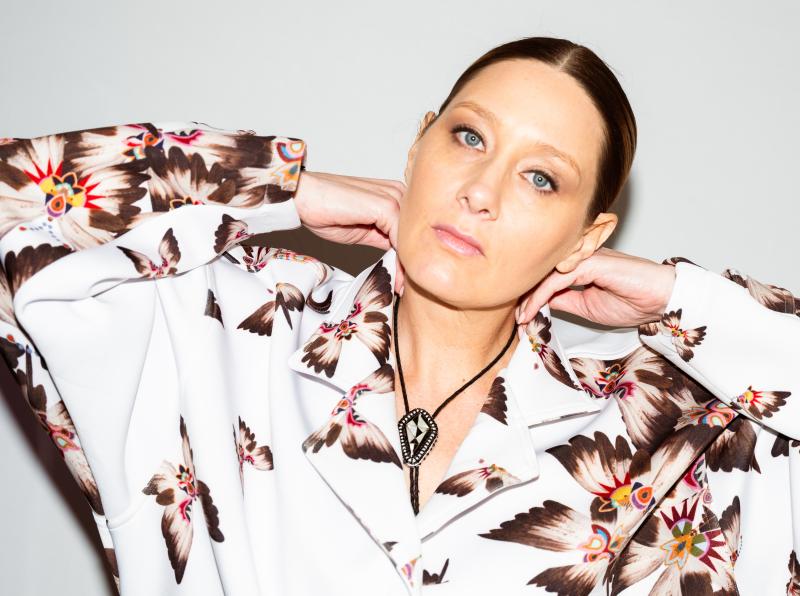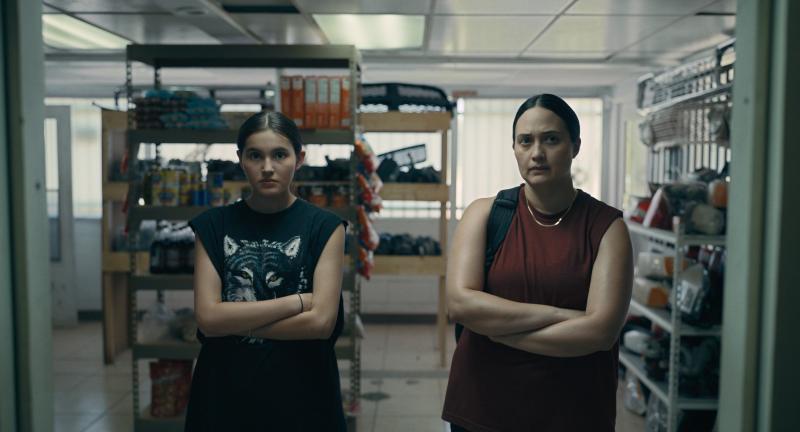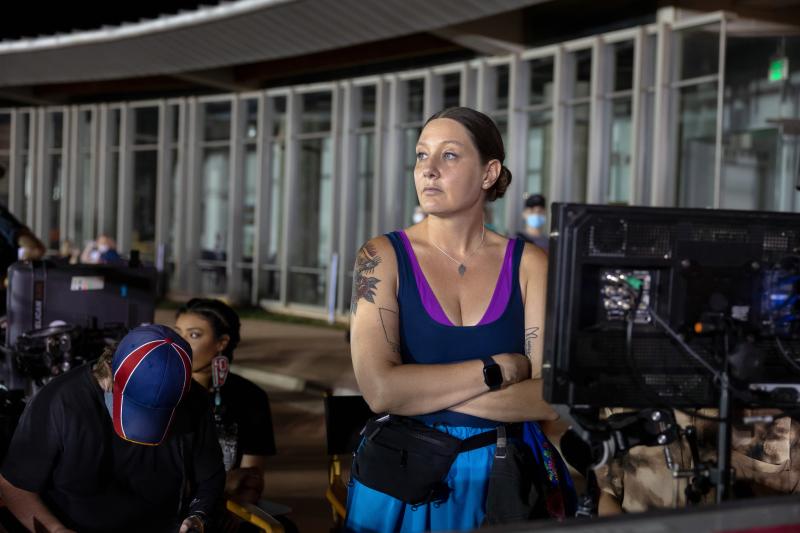Behind the Lens: A Conversation with Filmmaker Erica Tremblay (Seneca-Cayuga)

Erica Tremblay (Seneca-Cayuga). Photo by Lilac Milk
Growing up in the Seneca-Cayuga Nation, in the regions of Northeastern Oklahoma and Southwest Missouri, filmmaker Erica Tremblay (Seneca-Cayuga) always had a fascination with storytelling.
“From a very young age, I recognized storytellers in my community, whether it would be at school… or whether it would be in cultural gatherings, or whether it would even be my uncles and aunties telling stories with the family," said Tremblay.
Captivated by the physicality of storytelling, she explained, “I was always really drawn to and I noticed the physical leaning in. When someone was telling a story and it would get to this really important part, when people would physically lean in. Whoa, that is a superpower.”
Despite Tremblay’s limited access to cable television, she fueled her passion by renting Shirley Temple and Alfred Hitchcock films, as well as watching recorded MTV music videos, which opened up a window to the narrative power of stories being told effectively without dialogue.
On a full journalism scholarship at Missouri State University, a pivotal moment occurred when Tremblay watched the film High Art.
“I was coming into my queerness at that time. But at the end of the film, it said ‘directed by Lisa Cholodenko.’ And I was 21 years old when I realized that women could direct movies…I didn't even know that was a job for me,” she said.
Tremblay began making short films with friends, and after meeting a member of a David Fincher film crew, decided to move to Los Angeles, California, with $2,000 saved. Once in Los Angeles, she worked in various producer’s assistant and production assistant roles before securing a position as an entry-level producer at an advertising agency. However, the dream of filmmaking persisted.
“One day riding the train into work...I remembered this other dream that I'd had at one point, and that I'd kind of derailed that for health insurance at an advertising agency,” she said. “So, I took a chance, made a short film with Lily Gladstone (Blackfeet and Nez Perce) called Little Chief that premiered at Sundance in 2020. Then at that point, really decided to have a go at it.”
Taking a leave of absence from her job, Tremblay moved to a remote Canadian reservation to study her Native Cayuga language.
“I was doing an 8-hour immersion program learning language in the morning, and then I was writing at night,” said Tremblay.
Many people warn creatives to have a plan B in place and to never quit their day jobs, but Tremblay’s leap of faith led her to filmmaking success, directing short documentaries In the Turn (2014), Tiny Red Universe (2007), and Heartland: A Portrait of Survival (2012), as well as serving as writer/director/executive story editor on the FX television show Reservation Dogs.
Among her many accolades, perhaps her most notable role is director/producer/co-writer for the upcoming Apple TV+ film Fancy Dance, starring Golden Globe winner and Oscar-nominated actress Lily Gladstone and Isabel Deroy-Olson (Tr’ondek Hwech’in/Anishinaabe). The film centers around Jax (Gladstone) caring for her niece Roki (Deroy-Olson) on the Seneca-Cayuga Nation Reservation, balancing her search for her missing sister and helping Roki prepare for an upcoming powwow.
We spoke with Tremblay about her creative process for Fancy Dance, the importance of embracing Native traditions, and what she hopes people take away from her work.
NEA: What do you believe distinguishes films as an effective vehicle for storytelling?
ERICA TREMBLAY: Films are an incredible intersection between storytelling and moving pictures. And that is a magical place. I love being able to go into a nice cold theater or hitting play on my computer or TV at home, and being able to just sit through a story…that you're going to go on a journey from beginning, middle, and end. I love the completeness of that.
NEA: What sparked the idea to create Fancy Dance, and how have your language studies, heritage, and culture influenced your filmmaking?
TREMBLAY: I think for me, making a film that's so personal to my own experience as a Native American woman, my own experience as a human being living on this planet, it was easy to tap into people and things that I've witnessed that inspire me. I wanted to make a film about people who have inspired me throughout my life, and there's no greater inspiration in my life than Native American women and the queer folks that keep our community safe and our children safe.
When you learn the [Cayuga] language…you can hear our creation stories that are so woman-centric. You can hear our stories…and you can see just how important the roles of women were in leadership. If you don't know the gender of a person, you refer to that person as a she or a her. If it's a mixed group of people, they're all shes and hers. The translation for the word chief [is] "she has him by the horns." I was so inspired that I could actually for the first time in my life have a window into what it would be like to live in a world where women mattered…were integral to the everyday leadership and existence of a society.
That is what inspired me to write Fancy Dance. I wanted to imagine a modern-day world where young people speak the language, and where matrilineal kinship was the cornerstone of that community and that society, and in this case, this story. It was learning the familial words, your mother is Kno:ha, and your auntie, your mother's sister is Kno:ha-a'. And all of the land and longhouses and all of those things would flow from the mother to the daughters. Complete opposite of how things are now. You would take your kinship or your last name from your mother's side. Everything came down through the matrilineal side of things. I wanted to have a modern expression of what that would look like in a modern society that is so corrupted by all of these other things. So, you have these two women, these two Native American Cayuga women, who are traversing a tragic, dark, stark, demeaning world that has been placed upon them by systems that are out of their control. But yet, their kinship, their love for each other, their joy, their laughter, allow them to survive that and find their true expression of themselves.

Fancy Dance still of Roki [Isabel Deroy-Olson] (left) and Jax [Lily Gladstone] (right). Roki wears her missing mother’s purple jacket. Photo courtesy of Apple
NEA: Could you explain what fancy dancing and powwows are in Native culture?
TREMBLAY: Powwow is a cultural phenomenon in Native American communities, where you kind of come together, and there's a big grassy stomp ground, usually circular where people come together and there are dances. Powwow dancing historically kind of came about when it was illegal for Native Americans to practice their religious ceremonies.
There are different styles of powwow dancing—there's jingle dancing, there's smoke dancing. Fancy dancing was always my favorite kind of powwow dancing when we would go to powwows. The men wear these very big bustles with all these ribbons and bells, and they go out and it's like this very big expressive dance. I was always just totally blown away.
My favorite, most beautiful version of powwow dancing was always when the women would go out and do their fancy shawl dancing, because they would have these shawls that are so beautiful, that would like look like wings, and they would dance around. What's great about powwow is that you don't really have to dance to be powwowing, you can come and eat a corn dog and sit in the stands. It's really just about coming together and being together. Different nations can come together as well. It's not just specific to one Native American community. You can go to a powwow and you can see people from all different nations that are coming together.
NEA: What was the creative process that went into your filmmaking vision for Fancy Dance?
TREMBLAY: I put together a rough outline of what I thought the film could look like. I had met Miciana Alise (Tlingit) in a Sundance lab. I reached out to Miciana, and I said, “Hey, I'm working on this project, would you like to co-write with me?” I was so excited that she said yes. She's this incredible Afro-Indigenous Tlingit writer that just brings so much grace and integrity to everything that she works on. We wrote the film via Zoom. She was on the West Coast; I was on the East Coast. It was during the pandemic also, so we would go into our little black boxes and we would write together. We were just very inspired by the Native women that inspire us throughout our lives.
As far as research goes, certainly we were reaching out to people that we knew. We were reaching out to writers and researchers and knowledge keepers that knew around the Indian Child Welfare Act, and forced removal of Native kids. We were reaching out to…the Missing and Murdered Indigenous Women and Relatives space. We were able to reach out to folks from the National Indigenous Women's Resource Center, to talk to them about the topics of missing and murdered Indigenous women. Then the most important outreach that we were really doing as we were developing the film, was with knowledge keepers from my community. What parts of ceremony can we show? What parts should we not show? I am a Haudenosaunee woman, I am a Seneca-Cayuga woman, but I wanted to make sure that I was being responsible with what I was showing. So, it was very important to me from a very early stage that we had the input and the wonderfully generous thumbs up from people from my community. Then of course, I was working, I was going through language immersion at that time. So, the people in my language cohort that were all Haudenosaunee language learners, I would be bouncing ideas off of them, and making sure that what I was doing there was also culturally sound and how to weave in the language.

Fancy Dance still of Roki [Isabel Deroy-Olson] (left) and Jax [Lily Gladstone] (right), as they continue their mission to find Roki’s missing mother. Photo courtesy of Apple
NEA: While casting the film, did you have specific actors in mind for the roles of Jax and Roki?
TREMBLAY: I called Lily up and I was like, “Would you be interested in developing a feature with me?” She read things along the way, and I think from a very early stage, she already was starting to form [the role of] Jax in her mind. It was such a wonderful collaboration and Lily is so brilliant and so smart, and you want her notes on everything…it's really impossible to put how wonderfully lovely Lily Gladstone's brain is.
We watched dozens of tapes of brilliantly talented young actors, and I hadn't quite found the right Roki. I was working on a TV show called Dark Winds, and we were casting a pregnant teen. I was watching these casting tapes and Isabel came across my desk, and she looked way too young to play the pregnant teen that we needed for the show. But I was like, I need a 13-year-old for my movie. So, I immediately reached out to casting and I said, “Find this Isabel, get her on the phone, figure out if she would be interested.” We had a Zoom call, and she read for Roki, and I immediately knew that was our girl. And what was so wonderful is that Lily and Isabel truly bonded, and they have this beautiful friendship and relationship.
NEA: Could you share a highlight from your time on set?
TREMBLAY: I'm so grateful to the Oklahoma crew for showing up every day, [in] 100-degree weather and bringing this film to life so expertly and so wonderfully. There's always challenges in independent film. You never have enough. It's just all about getting creative. One anecdote that I really love to share is…during the pandemic, in order to keep the crew members safe, the cast members safe, and all the extras safe, we had to basically throw the powwow. We couldn't just go to a powwow, we had to actually bring everyone in.
We were shooting it overnight and we were really expecting a lot out of our extras to like show up at 8 pm and be there till sunrise. I remember going to the producers and being like, “I need money to buy a big screen TV.” And they're like, “What? You don't just get money.” And I was like, “No, I promise you if we buy raffle prizes, like real raffle prizes for the powwow that we're throwing, and we saved raffling off the big screen TV till the last prize, everyone will stay.”
So, one of our producers went out over the weekend and bought a big screen TV. Miciana and I bought a whole bunch of raffle prizes, and throughout the night, our actor MC was actually raffling off prizes. And at 6 am, we raffled off the big screen TV and they stayed. I knew they would stay because I know my community.

Erica Tremblay (right) and the production crew film a scene on the set of Fancy Dance. Photo courtesy of Apple
NEA: Your film shows a snapshot into the ongoing issue of missing and murdered Native women. What message are you aiming to convey about the lack of attention this crisis receives? Overall, what do you hope people take away from watching the film?
TREMBLAY: When we set out to make the film, we never wanted this to be a procedural—we never wanted this to be a film that's explicitly talking about these issues. We made a very conscious choice from the outset that we would never see a dead Native woman's body. We would never go into gruesome details or explicit details of the violence that has become of this person. We really wanted this film to be about two Native women in modern America. As a Native person, you can't go on social media without seeing a missing poster. It's like every other day, you're seeing a new missing poster. It's so prevalent in our communities, that our people go missing and that our people are murdered and never receive justice.
What we did was we decided that these issues—forced removal of Native children, violence against Native peoples, the disintegration and the theft of our languages, extractive industries coming into our communities and bringing crime and violence—we wanted those things to be on the periphery…while this beautiful story of love and perseverance and joy was happening between two Native women.
We wrote this for Native Americans. It absolutely has global, human experiences in them that anyone and everyone can watch and enjoy, and we hope that people do. We want Native Americans to watch this and feel a hug, and the love, and get to see a small piece of Native American life expressed. We want people that aren't Native or people that don't know about these topics to learn about them and know about them. I hope that when non-Native people watch this, they recognize their inherent relationship to their Native American neighbors, and how it's up to them to figure out how to be better and best neighbors. But mostly, I just want Native people to feel loved.

Erica Tremblay (center) directing on the set of Fancy Dance. Photo courtesy of Apple
NEA: What projects are next for you? Will there be a sequel to Fancy Dance?
TREMBLAY: I'm writing and directing on a television show right now called Dark Winds. I'm developing a television project. I'm adapting a really wonderful horror novel that I hope to write and direct. I'm developing a thriller with Miciana. I'm really just excited about what the future may hold.
It's been a dream of mine…since I was a little girl, to be a storyteller. I'm not taking this for granted. I'm allowing myself to live in every moment that I have the opportunity to do this as a creator. I really can't wait to see what the future holds. And as for a sequel, I always saw the image of Jax and Roki at the end of this film as the finality of how I wanted to take the story. I wanted Jax and Roki to have a moment of revelry, to have a moment of connection, to have a moment of joy, to have a moment of dance.
You can watch a trailer of Fancy Dance (available via Apple TV+ on Friday, June 28) below!




